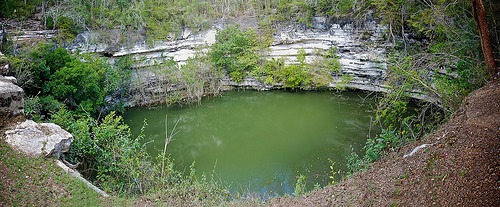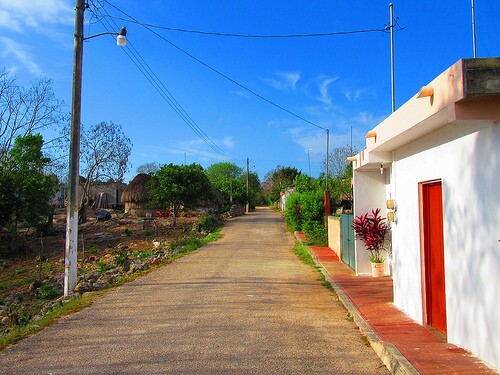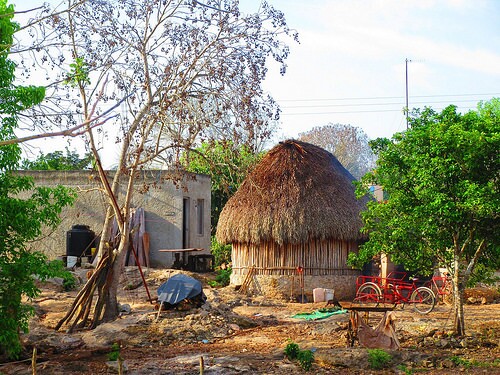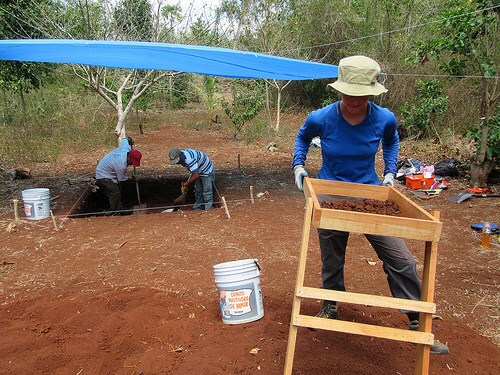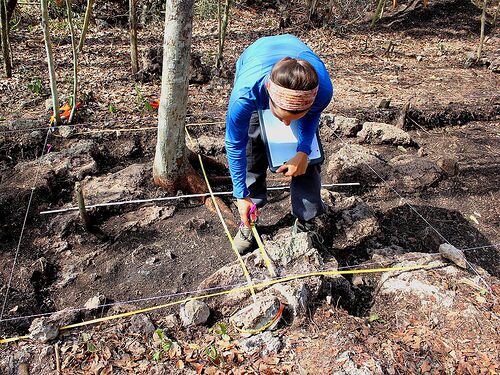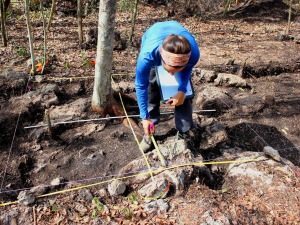
Known as el Mayab before the arrival of the Spaniards, the Yucatán in Mexico was populated by the ancient Maya and perhaps best known for great ancient Maya cities such as Chichén Itzá and Uxmal. But it was not a naturally friendly place for farming. Its shallow soil composition and expansive natural foundation of karstic limestone bedrock made it, to say the least, a challenging environment for gardening and agricultural production.
Something called a rejollada likely made a significant difference, however. That’s what Kate Leonard, a young Canadian archaeologist who recently excavated in them, discovered in April of 2016.
“A rejollada is a large circular sinkhole in the natural limestone bedrock that often contains deep moist soil,” says Leonard. “They’re actually quite large. I was surprised when I walked down into my first one. They do vary in size but the ones we were excavating could fit a soccer field in them. They are large enough that it is difficult to indicate in a photograph that you are in a deep depression.”
Most importantly, they seem to have been a life-saver for the ancient Maya when it came to gardening and growing edible plants.
“In a dry landscape with very little topsoil it’s understandable that these were (and still are) highly valued as locations for gardening. In the past maize and other vegetables were likely grown in them, as were the important crops of cacao and cotton,” she adds. Leonard says that the village of Tahcabo, where she has been excavating, has been occupied since the Late Preclassic period (~450 BCE-100 CE), and that the numerous rejolladas and two large cenotes (natural, water-filled sinkholes) in the area made the village a very desirable place to live for the early Maya settlers. It may explain one way the ancient Maya people managed to live and even thrive in what otherwise would have been a relatively inhospitable environment for a developing civilization.
________________________________________________
Cenotes and rejolladas are among the distinctive geological features of the Yucatán Peninsula. Depicted here is the large sacred cenote at Chichén Itzá. Emil Kehnel, Wikimedia Commons
_____________________________________________________________
Arriving and staying in the larger village of Calotmul, located in the center of the Yucatán Peninsula, Leonard and her working companions drove each day twenty minutes through rural bush and agricultural land to reach Tahcabo, where the targeted rejollada excavation sites were located. Leonard was part of a group of investigators and excavators with the Proyecto Arqueológico Colaborativo del Oriente de Yucatán (PACOY) Project working under Dr. Patricia A. McAnany of the University of North Carolina, Chapel Hill, along with InHerit, and Dr. Iván Batún Alpuche of the Universidad del Oriente in Valladolid and the State Archives of the Yucatán. Leonard, for her part, worked closely with Field Coordinator Maia Dedrick, who was conducting primary research for her doctoral dissertation by excavating 2m x 2m trenches in six of Tahcabo’s rejolladas.
“We’re excavating rejolladas and abandoned settlements in order to better understand changes in Maya horticultural practices that took place when Spaniards first came to the area around Tahcabo,” says Leonard. “The Rejolladas are natural solution sinkholes in the karstic limestone that collect rich soils ideal for cultivation.”
_____________________________________________
Above and below: A streetscape of the small village of Tahcabo, and a typical home site in Tahcabo. Photo courtesy Kate Leonard
________________________________________________________________
Above: A 2x2m excavation underway in a rejollada. Photo courtesy Kate Leonard
__________________________________________________________________
Planning limestone at the end of an ancient settlement mound. Photo by M. Dedrick of PACOY
______________________________________________________________
The archaeologists are systematically taking archaeo-botanical samples to analyze and compare the plant remains at different depths and then dating them using radiocarbon dating (C14) techniques. The study will hopefully provide a picture of how the horticultural practices in Tahcabo changed over time, including after the arrival of the Spaniards. “The rejolladas located in Tahcabo itself are still used for gardening, for making earth ovens (píib) and for conducting the Ch’a’ Cháak rain ceremony. There are usually chickens wandering through and there could be vegetables growing, tree crops, animals, or some other activity taking place,” says Leonard. Thus far, reports Leonard, two rejolladas have been completely excavated and another one started, including the surface excavation of a nearby abandoned settlement.
Excavating in the Yucatán environment at this time of year was not easy work. The relentless heat alone made it almost unbearable, she related. “I only stopped sweating between the hours of 4 am and 6 am. In order to beat the heat we began work on site at 7:30 am and began packing up at 1:30 pm.” Lunch time broke the day from the labor of the morning hours, with the welcome consumption of traditional Yucatecan Maya Mexican food prepared for the excavators daily. After lunch, a much-needed one-hour rest break at the dig house would be followed by two hours of lab work entailing paperwork, data entry and doing flotations.
There is more work ahead. “The season will continue on throughout the spring and summer so much more will be accomplished,” she says. But, as much as she would like to stay, Leonard would not be there to see the season to its end. At the time of this report, she had already moved on to her next destination. Her time in the Yucatán was actually part of an ambitious enterprising global project she hatched on her own to volunteer her knowledge and skills to work at no less than 12 projects in 12 countries in 12 months. Tahcabo was to be her fourth stop on her globe-trotting worldwide archaeology project, what she has called Global Archaeology: A Year of Digs.
Popular Archaeology will be following and reporting on Leonard’s worldwide experiences periodically throughout 2016 as she hops from one location to another during her global journey. To continue the work, however, Leonard will need financial support from donors. Readers interested in reading about and supporting her self-directed Global Archaeology crowdfunded project can learn more at gofundme.com/globalarchaeology.
See more about Leonard’s experience with the PACOY Project here.
____________________________________________________________

______________________________________________
Travel and learn with Far Horizons.
____________________________________________
This richly illustrated issue includes the following stories: Recent findings shedding new light on the whereabouts of the remains of Philip of Macedon, father of Alexander the Great; how an archaeologist-sculptor is bringing bones of the dead back to life; archaeologists uncovering town life at the dawn of civilization; an exclusive interview with internationally acclaimed archaeologist James M. Adovasio about what makes the Meadowcroft Rockshelter prominent in the ongoing search for the first Americans; what archaeologists are finding at the site of the ancient city of Gath, the home town of the biblical Philistine giant, Goliath; and how scientists are redrawing the picture of human evolution in Europe. Find it on Amazon.com.

